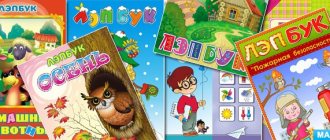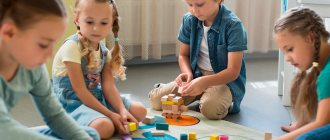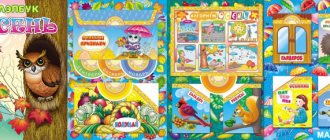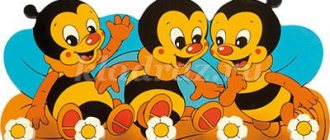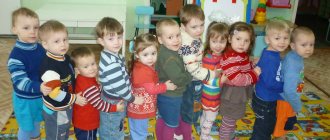As children grow up, many questions arise: “What is this?”, “What is this for?” etc. Adults should pay more attention to a child who is actively developing. In this article we will look at tips on how to easily and quickly teach kids the names of the months of the year.
Children are interested in various topics, including serious ones. When parents encounter something like this, they begin to wonder how to properly answer or explain. For example, they hear the question: “Mom (dad), what is November?” How can you explain to your child in an accessible way that there are 12 months in a year, of which 3 are winter, 3 spring, 3 summer and 3 autumn? That every month has a name, that January is a winter month, and July is a summer month? How to learn the names of all months with your child? And not just find out, but teach them to distinguish them based on specific characteristics?
Where to start learning?
It is necessary to begin the explanation with what a month is in general, how many there are in a year, and why it is customary to divide the year into seasons. Then you need to talk about the generally accepted procedure and begin training by studying the months, starting with the first - January.
Note! A quick way to remember the number of days in a month: clench your fist and look at the bones. The first is January. The month on the bone has 31 days, on the socket - 30.
GBPOU "Solikamsk socio-pedagogical
It is better to decorate the bedroom according to the principle of such a season as “Winter”.
Why? Winter wraps nature in sparkling whiteness. The multicoloredness in life subsides, despite the green of the pine needles, the radiant blue of the winter sky and the ardor of sunsets.
The dominant color in the winter color scheme is blue. The blue color sets the tone for the design. But not only cold colors are used, there are also others - warm tones, for example, yellow, orange, radiant blue, radiant yellow - these are tones that are suitable for winter. After all, the sky in winter is sometimes yellow. The combination of yellow with violet, blue with orange is suggested in the “winter interior” in accordance with the additional colors of the color wheel (show).
In general, in the interior designed according to the principle of such a time as “Winter”, you feel coolness, which contributes to a restful sleep. Blue color reduces emotionality, lowers blood pressure, which has a calming effect on the body and psyche of children.
Cool green color reduces sensitivity to noise. Therefore, the child will feel more relaxed in the bedroom.
Interior design of a playroom in a kindergarten based on the “Seasons” principle
A conscious approach to choosing colors is especially important for the playroom, where children spend the most time. This choice must meet several requirements:
Meet the spiritual needs of children;
Reduce the flow of irritants;
Promote the development of children's creativity;
Depending on their age, children exhibit distinct inclinations that must be taken into account when decorating a room. But there is one important rule: a clear and unambiguous, welcoming color mood should reign in the playroom so that the child is not overexcited or distracted. It is also recommended to decorate large surfaces, such as walls and floors, in light, restrained shades; smaller areas are the same. Like curtains, toys, racks, shelves - on the contrary, in strong colors. Furniture, tables for games and work should be as neutral as possible, preferably natural wood.
From all of the above, we can conclude that this room is more suitable for a time of year like spring. The colors of spring are light and joyful. After all, in spring nature wakes up from hibernation and the colors are not yet bright, but they explore the joy of optimism. The main color of spring is yellow, so the playroom is decorated in a light yellow color. I combine spring colors with natural materials - like wood, stone, metal, I need to give them a yellowish tint. The surfaces of objects should be smooth, soft, silky.
So, the spring color scheme in the playroom should radiate joy and optimism. The main thing is not to overload the space with bright colors, because... long-term exposure of a child to a richly colored interior will lead to fatigue, irritability and even aggression.
Interior design of a locker room and art studio in a kindergarten based on the “Seasons” principle.
Locker room
This part of the daycare makes a nice transition from outside to inside the group room.
Ideally, a color scheme that would be welcoming and inviting, but would not encourage you to stay here for a long time. The optimal seasons for the locker room are autumn and spring. Red and yellow are the primary colors here. They have a welcoming effect and, if you use strong tones, invigorating.
When decorating a locker room based on a time of year like autumn, you can use contrasting earthy colors to create an atmosphere of a friendly climate. This color scheme simultaneously excites and gives strength for the whole day.
Art studio.
An art studio is a drawing room where a child’s creative process takes place. Therefore, the color scheme of the art studio should stimulate the creativity and imagination of children.
Summer is the most suitable time of year for this room. Summer colors allow you to solve imaginative problems, fantasize, dream. This is exactly what is needed for successful activities in the field of fine arts.
Summer colors are somewhat muted, bleached, and sun-bleached. The main color at this time of year is blue. This is what gives all summer tones a cool bluish undertone. A smoky veil is typical for summer, giving many colors a discreet elegance. Summer color nuances of pink, roses, phlox, etc. can be used in the interior.
Furniture and colors in shape, structure and color should be restrained - elegant.
Names of the months in children's pictures
All children love games. It will be more interesting and easier for your child to learn the names of the months if he is shown story-based illustrations or presentations. If parents independently make a presentation about the seasons for their child, it will be even better. An excellent option is to create it together with your child. This way he will remember the names faster.
By finding illustrations about each month and showing them to the child, the parent will be able to fix their names in his memory. To do this, you need to select pictures that demonstrate the life of animals in each season, the type of clothing for each season, etc.
To interest your son (daughter), the presentation must be colorful. You can also display the features of each month. For example, September - leaves fall, the school year begins, and children go to school. In presentations, you can focus on holidays. For example, December - New Year, decorating the Christmas tree and home. Be sure to include the child’s birthday in them - he will definitely know and remember this day.
Winter months
The child needs to be explained that there are 3 winter months - December (ends the year and begins winter), January (begins the year) and February (the harshest month, with blizzards and snowfalls). It is important to choose thematic pictures for the story.
Spring months
The first month of spring is March. This is the period when primroses - snowdrops - appear. The second month is called April. This is a period of changeable weather: sometimes the sun shines, sometimes it rains. The third month – May – is the time when nature begins to clothe the forest. Plot illustrations are also appropriate for the explanation.
Summer months
June is the first month of summer. In ancient times it was called “worm”. This month has the longest day and shortest night of the year - June 22. June is followed by July, the month when linden blossoms intensively. Summer ends - August - time for harvest. In addition to pictures, you can choose riddles that describe each month.
Autumn months
There are also 3 autumn months: September (early autumn), October (golden autumn) and November (late autumn). To describe the season, you can select signs for each month.
Didactic manual “Seasons”
Didactic manual “Seasons”
Target:
to form in preschool children ideas about seasonal changes in nature based on trees.
Tasks _
:
to form in children knowledge about the characteristics of the seasons, their main features, turnover, periodicity and cyclicity using the example of a tree;
to form initial knowledge of environmentally literate behavior that is safe for nature and for the child himself;
form elementary mathematical concepts: many and one, comparison of equal and unequal groups of objects, etc.;
develop sensory perception, develop fine motor skills, curiosity, develop spatial orientation: top - bottom, right - left;
expand and enrich children’s vocabulary on the topics “Seasons”, “Birds”, “Why are trees needed?”;
stimulate children's creative activity;
cultivate love and caring attitude towards nature.
This didactic manual is intended for children 3-7 years old, perfect for individual and subgroup work with preschoolers.
The “Seasons” tree can be used in the following educational areas: social and communicative development, cognitive development, speech development, artistic and aesthetic development. The trunk and crown of the tree are made of thick cardboard. The crown of the tree is filled with glazing beads on which models and pictures of objects are hung. The manual includes models of leaves, fruits (apples, pears), flowers, snowflakes, pictures of birds, pictures of symbols.
When working with the manual, various options for game tasks and exercises are used, taking into account the age and individual characteristics of children.
Methodological techniques for working with the didactic manual.
Conversations, viewing, reading poems and stories about the seasons, birds, writing short stories, solving riddles, didactic games.
As instructed by the teacher or independently, children can hang models and pictures of objects on the tree.
Game
"When does this happen?"
Target:
consolidate children's knowledge about the characteristic signs of the seasons.
Material:
object models, pictures with signs of the seasons, cards with seasonal clothing, magnetic board.
Progress of the game:
Option 1.
The teacher tells the signs of a particular time of year, what is happening in nature, what the weather is like, so that the child can feel and vividly imagine the picture of the season. Then he invites the child to look at object pictures with signs of the seasons, select pictures that correspond to the description, select cards with seasonal clothing corresponding to the time of year (explaining his choice), and place them on a magnetic board. Next, the teacher asks the child to show on a model of the tree, using models, what a tree looks like at this time of year.
After the child has completed the task, you can:
- ask to name the months of a given time of year;
- ask the child “How does he feel about this time of year?”, “Why does he like or dislike this season?”, What time of year is it on Earth now?”;
- invite him to tell a story that happened to him at this time of year.
For example.
The teacher says:
“The sun shines brightly, but gives little warmth. It does not remain in the sky for long: the days are short and cold. There are severe frosts. The whole earth is covered with snow. Strong snowstorms and blizzards are common. Rivers and lakes freeze, so you can walk and drive on the ice.”
“Every day the sun noticeably warms up, the days become longer. Snow and ice are melting. Streams run, rivers and lakes overflow. The grass appeared, the primroses bloomed. Migratory birds are returning from warm countries.”
“The sun is high, shining brightly, warming well. The weather is hot. Everything in nature grows and smells fragrant. Flowers are blooming, berries and mushrooms are appearing in the forest.
“The days are getting shorter, the sun is lower. Cold winds blow, it often rains, and the sun is completely invisible behind the clouds. Migratory birds gather in flocks and fly away to warmer regions.”
Option 2.
Four seasons - winter, spring, summer, autumn. And each is beautiful in its own way. There is nothing more constant than the change of seasons.
You can make the game more difficult. Invite your child to arrange subject modules on a tree, displaying all the seasons, starting with winter (spring...).
The child must visually divide the tree crown into four sectors and hang on them object models characteristic of each season.
To learn the material and make the game more interesting, you can use poems and riddles.
Game:
“Who flew where?”
Target:
consolidate children's knowledge on the topic “Birds”.
Materials:
object models and pictures (feeder, birdhouse, wintering and migratory birds), riddles, cards with descriptions of birds.
Progress of the game.
The teacher invites the children to hang pictures of birds in accordance with the assignment.
For example. The teacher hangs object models on a tree, characteristic of a particular time of year, and says: in winter (spring) many birds flew to the tree. A bird has flown to the topmost branch of a tree and is reading a riddle about a bird. The child who solved the riddle finds a picture of this bird and places it on the tree (on the top branch). The teacher continues: a bird sat down to her left and reads the riddle again, the child who guessed the riddle finds the picture and places it on the tree. The adult says that there are two birds on the feeder and reads the riddle. Having guessed the riddle, the child must find two pictures of identical birds and place them on the feeder...
After hanging the birds, you can offer the children:
- name the birds using the words: above - below, right - left, on, near, between; count all the birds that flew to the tree,
- ask to explain why these birds are called wintering (migratory);
- offer to tell about a bird;
- come up with a short story (history) of what happened next.
Game:
“Tall Tale”
Goal:
development of logical thinking, the ability to notice a fable, to prove why this does not happen.
Materials:
object models (leaves, fruits, flowers, snowflakes, wintering and migratory birds), picture of a feeder, birdhouse.
Progress of the game.
The teacher places subject models on the tree. Then he invites the children to look at the tree and determine whether they are all placed correctly.
For example. The teacher chooses the season - winter. He hangs a birdhouse, snowflakes and birds (crow, bullfinch, starling) on the tree.
Next, the child is asked to consider this time of year and determine whether everything is correct, correct it, explaining his choice.
You can also invite children to make up their own fables using the same principle.
Game:
“Trees are our friends!”
Target:
to develop children's knowledge about the benefits of trees on the planet.
Materials:
cards - symbols (symbols).
Progress of the game.
The teacher asks the children: “Do you know why trees are needed?” After the conversation, he invites the children to place cards with symbols on the tree model.
For example. The teacher reads the phrase:
“Trees absorb carbon dioxide and produce oxygen, without which no living creature can breathe,” and the child must match the symbol card to what he heard.
“Many birds and wild animals make their homes in trees.”
“Trees serve as a barrier to the wind, which carries dry soil away.”
“Trees prevent rainfall from destroying the soil.”
“Tree foliage traps dust and reduces the concentration of harmful gases in the air”
“Green spaces play a big role in noise control. (Sounds are not absorbed by the foliage of trees. When they hit the trunk, sound waves are broken, heading down to the soil, where they are absorbed).”
“We need trees as a source of wood”
“It’s good to hide under the canopy of trees in the heat. (In the shade of the garden on a hot day, the air temperature is 7–8 C lower than in the open.)"
“And trees also greatly decorate our land!”
After you have hung up the symbol cards, you can offer the children:
- come up with a short story (story) about how he and his mother, father (teacher) planted seedlings in the spring;
- think about why people plant trees, how to protect trees.
How to learn the names of the months from books
Experts recommend buying children's educational and developmental books about the seasons and months. Such manuals explain to children the features of nature and the signs of the months in an accessible way. Some editions of such books contain tasks for consolidating material that will strengthen the memory of the topic studied.
Poems can help you learn the names of the months. After studying them, your memory will improve. You need to buy special literature with poems, fairy tales and stories about the 12 months. The book “365 Bedtime Stories” has proven itself to be excellent. The pictures in it are sorted by season, and each page corresponds to one calendar day. The book contains poems and stories that fully explore the theme of the 12 months. It's great for teaching with kids. No less useful is the encyclopedia “Seasons” with answers to many questions.
Cube
To make an educational cube with the seasons, you need to prepare four applications with thematic pictures and the base - a cube template.
It is better to make applications together with the children, so that as you work, you can talk about each season in detail. We also draw and cut out the details of the appliqués together with the kids.
The base of the cube must be made strong. The best option is a corrugated cardboard box from a store. The size of the appliqués must correspond to the dimensions of one side of the geometric figure.
We paste the finished pictures onto the cube template, assemble it and fix it with glue.
Learn the names of the months by playing
Theatrical scenes will help your child remember the names of the months and seasons. The child can be both a participant and a spectator. You can also pick up riddles or come up with them yourself. For example, draw people wearing clothes according to the seasons and ask the child to name what time of year they wear such clothes. Drawing pictures with your child that correspond to each season will also be useful.
A great way to learn and remember the months is a didactic game. They are developed specifically for preschool children. They also demonstrate relationships with the environment, develop memory and logic.
Information that is interesting to children is remembered quickly. They always want to learn a lot of new things, so they ask adults questions and explore the world. Children are good communicators who know how to listen. Studying the months is a fun topic for a child. He will be happy to study it with mom or dad.
Tree panel “Seasons” for kindergarten: how to make it yourself
We will look at what a paper panel manufacturing scheme looks like. But there are other variations. A cardboard tree can be covered with a special fabric so that objects with Velcro can be attached to it. This will make it easier for the child to remove the toys and return them. You can use regular fabric. Make small slits in it for some decorations on hooks. The baby will be able to pull them out, play with them, and hang the items in place.
A paper panel is easier to make. Items are mainly laid out on a circle. Some plasticine figures or small toys can be leaned against the trunk. How to make a paper tree game:
- To create a model of the tree, we will use old newspapers. It is enough to draw two identical sides of the tree.
- Cut out shapes from newspaper and attach them to cardboard. Carefully trace with a pencil and cut out cardboard trees along the drawn lines.
- We conditionally divide each fragment in half with a vertical line, draw it from the beginning of the trunk to the top of the head.
- We cut one part along the line from the bottom to half, the other fragment - vice versa. We start cutting from the top, moving also to half.
- We connect the two blanks by inserting them into the slot. We get a tree divided into four parts.
- We make the base in the shape of a circle. It should be proportional to the tree. We fix the figure in the center of the circle. To make the layout durable, you need to apply glue vertically and horizontally along all the joints.
- We dilute the glue with a small amount of water. We glue napkins to all surfaces. The cut area should not be noticeable. To obtain a relief structure of the foliage on the tree, the trunk and the surface around it, we crumple the wet wipes a little during the gluing process.
- We leave the layout to dry for a couple of hours.
- Using paints, paint each quarter in the appropriate color. For autumn we choose yellow, orange, brown tones. Spring – a mixture of white and soft green; you can add snowdrops and tulips. Winter in cold shades of gray, blue, white. We make summer bright, yellow, green, blue.
Sew Vogue Patterns with your own hands: pattern, diagrams and description
Fiesta and siesta: what is the difference, how to distinguish correctly, characteristics
Design of the subject-spatial environment “Seasons”
The design of the “trees”
(birches)
is made of colored paper; depending on the time of year, you can change the color of the foliage.
“Forest Lawn”
is made from colored paper from the
“Bunny”
.
A creative approach to the design of the group will help make its interior original and bright.
The color scheme is selected by us in accordance with color perception. Orange color – charges with positive energy and vigor; shades of green are also well suited for a child care facility, since if used in moderation, they have a great effect on the child’s psyche;
The hedgehog is made from ceiling tiles and toothpicks; the material is accessible to everyone. This wall decoration can be used for any time of year. Depending on the time of year, you can place leaves, fruits, snowflakes. The clearing can also be decorated with green grass, dry leaves, and snowflakes.
Publications on the topic:
“Kindergarten is a fairy-tale world.” Design of a developing subject-spatial environment “Kindergarten - a fairy-tale world” What attracts me to working as a teacher in a kindergarten? I asked myself this question in the first years of my work.
Modeling of the subject-spatial environment in a preschool educational institution Nina Petrovna Tregubova, teacher of S/P - kindergarten No. 9 “Dolphin”, Neftegorsk Modeling of teaching staff - preliminary development of the main ones.
Designing a subject-specific spatial development environment for the Federal State Educational Standard (FSES) corner “Seclusion” Designing a subject-specific spatial development environment according to the Federal State Educational Standard is always not easy. Especially when the area of the play group is small and the occupancy is small.
Design of a subject-specific spatial development environment. Corner “Seclusion” Designing a subject-specific spatial development environment according to the Federal State Educational Standard is always not easy. Especially when the area of the play group is small and the occupancy is small.
Design of a developing subject-spatial environment for a pedagogical sandbox. What is needed to play sand? But, in essence, so little is needed: Love, desire, kindness, So that faith in childhood is not lost. The simplest drawer from the table.
Decoration of kindergarten. Organization of a developing subject-spatial environment in the preparatory group. In each preschool educational institution, the developing subject-spatial environment performs educational, nurturing, developmental, and stimulating functions.
Project “Ways to enrich the developing subject-spatial environment of a kindergarten site in the spring-summer season” 1. Relevance of the problem: Children’s stay in the fresh air is of great importance for physical development. Walking is the first.
Creation of a subject-spatial environment in a preschool educational institution State budgetary preschool educational institution of a combined type No. 56 of the Frunzensky district of St. Petersburg.
